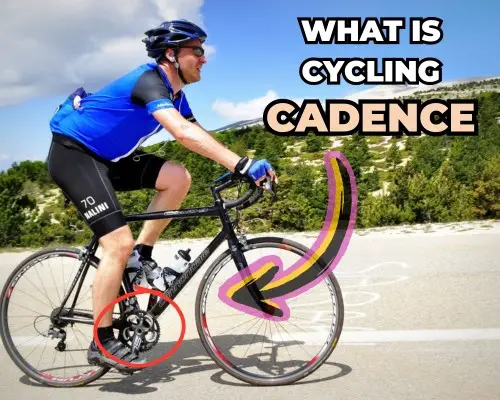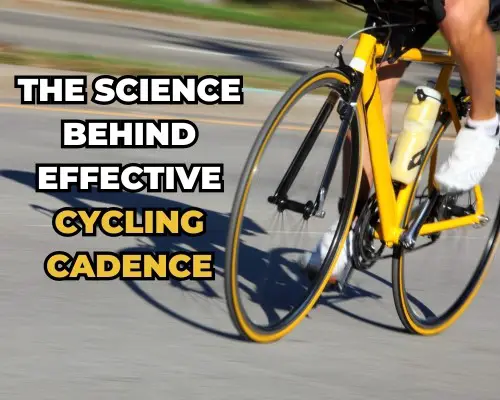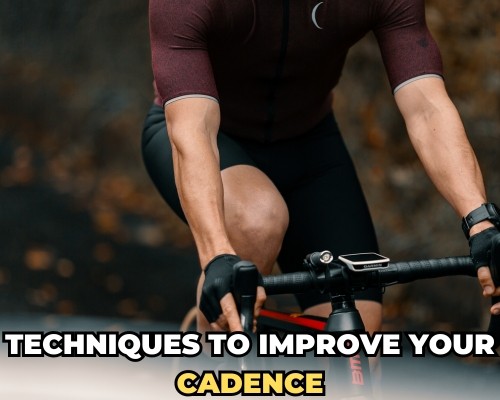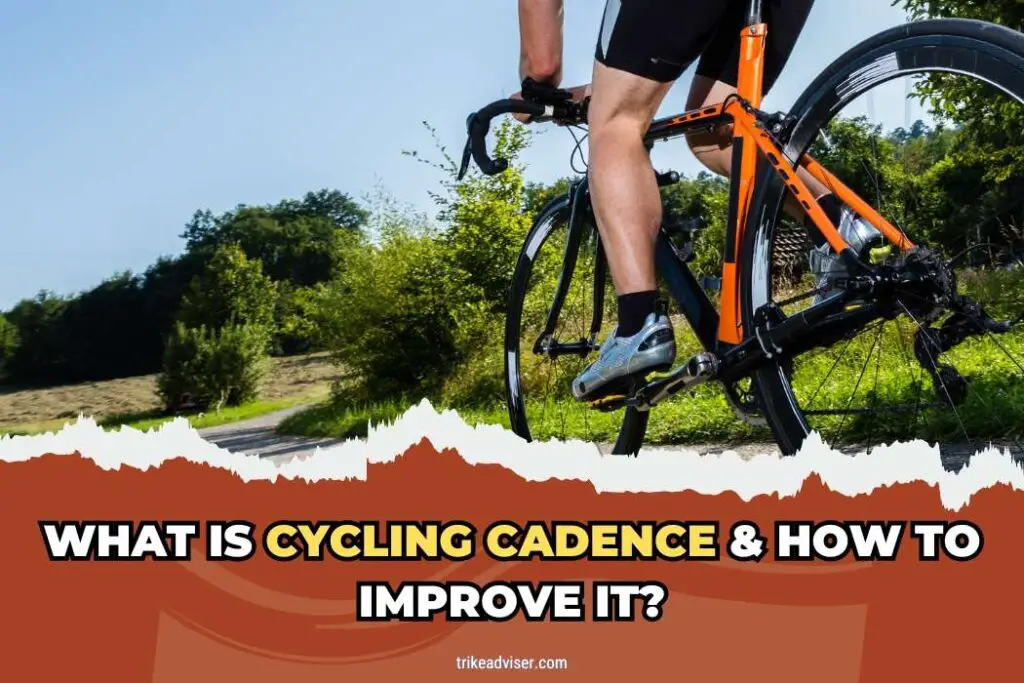Cycling cadence, sounds simple, right? Many cyclists pedal without thinking about it. They hop on, start moving, and let instinct take over. But here’s the twist. Your cadence could be what’s holding you back.
Ever felt like you’re pushing too hard but going nowhere? Or spinning your wheels too fast, getting tired quickly? That’s cadence at play. It is the number of times your pedal does a full rotation in one minute. Isn’t this surprising?
Most don’t realize its power. Improving it can feel like unlocking a secret level in a game. You become faster and more efficient. The challenge?
It’s not just about pedaling faster or slower. It’s about finding your sweet spot. And that journey, my friend, is what makes all the difference.
What is Cycling Cadence & How to Improve It? – Train Your Cadence

Cadence in cycling, ever wonder about its buzz? It’s a blend of art and science. Picture this: two camps in the cycling world. One chants “spin to win,” and the other trusts what feels natural. But here’s the kicker: no universal cadence suits everyone. Look at legends like Nairo Quintana and Chris Froome. Opposites in cadence, yet champions all the same.
Cadence is tied to your power and the bike’s speed. Notice how your legs move faster when you push hard? That’s about a six RPM jump for every 100 watts. But remember, power drives cadence, not vice versa.
Flat roads might see you buzzing at around 95 RPM. Hit a steep hill, and it drops to 70-75 RPM. Why? It’s all about inertia. Climbing feels different, and so does your pedaling.
Optimal cadence? It’s a myth. Your perfect number shifts with the road, effort, and conditions. Big legs, muscle fiber types, and even your age factor in. And whether you’re cutting through wind or drafting.
Elevating Your Cadence
The Cadence Spectrum
Think of cadence as your cycling fingerprint. Unique. Your mission? Find what works for you. It’s not about mimicking the pros but tuning into your own rhythm. A too-fast cadence can tire you quickly, while too slow can strain your muscles.
Gear Games
Gear choice is pivotal. It’s like choosing the right key for a song. Start with what the road gives you. Flat stretches? Go higher with your RPM. Facing a climb? Shift down but keep it smooth. This isn’t just practice; it’s about making peace with your bike.
Tailored Training Drills
- Low Cadence, High Power: Embrace the grind on climbs. Lower RPM, but don’t sacrifice tempo. Think 50-60 RPM. It’s tough, akin to a strength workout but on your bike.
- Sprint from Standstill: Channel your inner track sprinter. From zero to hero in heavy gear. Aim for ten full-effort sprints. It’s brutal but builds raw power and muscle memory.
- Spin to Win Drills: Now flip it. Light gear, aim for 120-130 RPM. It’s less about power and more about finesse. This drill refines your pedal stroke, making every revolution count.
The Science Behind Effective Cycling Cadence

Cycling cadence isn’t just about the legs moving in circles. It’s the rhythm of the ride, the heartbeat of your journey. Let’s peel back the layers.
Understanding Muscle Use and Fatigue
- Personal Experience: Picture this. A climb so steep, your legs scream with each pedal stroke. Your cadence? It’s all over the place. That’s when it hits you. Cadence isn’t just a number; it’s your ride’s lifeline.
- In-Depth Insight: Scientists say, cycling at your unique optimal cadence minimizes muscle fatigue. Why? It’s all about efficiency. Strike the right balance, and you recruit muscle fibers just right, delaying that burn.
- Pro Tip: Experiment on your next ride. Shift gears, and adjust your rhythm. Find that sweet spot where effort meets endurance. That’s your cadence.
Cadence and Aerobic Efficiency: Finding Your Optimal RPM
- A-Ha Moment: Remember your first long ride? Breathing hard, wondering if you’d make it. That’s when cadence becomes your best friend. The right RPM can turn a grueling ride into a smooth journey.
- Solid Fact: Research suggests 80-90 RPM is the sweet spot for most. It’s where you’re efficient, and powerful, yet not gasping for air.
- Seasoned Advice: Grab a bike computer. Start tracking your RPM. Look for that range where you’re fast yet comfortable. This is your efficiency zone.
The Real Impact of Cadence on Power Output and Speed
- Truth Told: Higher cadence isn’t just for the pros. It’s for anyone who wants to ride smarter, not harder. It’s about translating effort into speed, seamlessly.
- Evidence Shows: For each increase in cadence, there’s a slight decrease in the torque needed. What does this mean? Less strain, more speed, if you can keep the rhythm.
- Expert Strategy: Play with your gears on a flat stretch. Aim for that fluid motion, where your legs almost feel weightless. This is where speed meets ease.
How does cycling cadence affect performance?
Cycling isn’t just about moving forward. It’s about how you do it. Cadence, that rhythmic pedal stroke, plays a starring role. Let’s dissect its impact on performance.
Neuromuscular Function
- The Core: Your muscles and nerves are in constant chatter. Cadence dictates the tone of their conversation.
- When off Beat: Imagine pedaling out of sync. Your muscle recruitment goes haywire, reducing your force output. It’s like a misfired engine.
- Keep it Smooth: Find your rhythm. It keeps the neuromuscular dialogue fluent, enhancing your ride.
Power Output
- The Physics: Power equals force times velocity. Cadence impacts both. It’s the dial on your engine’s efficiency.
- High vs. Low: Speed up, and you lighten the load on each stroke. Slow down, and each pedal packs more punch. The key? Balance.
- Optimal Efficiency: Seek your sweet spot. Not too light, not too heavy. It’s where your ride feels almost effortless.
Fatigue
- The Long Haul: Ever noticed how some rides leave you more drained than others? Cadence is a culprit.
- High Cadence: It’s like a sprint. Fast, frenetic, but taxing on the heart and lungs over time.
- Low Cadence: Picture climbing a mountain. Each stroke is a battle, sapping your muscles’ strength.
- Balance is Key: Aim for a cadence that keeps you in the saddle longer, without the burnout.
Tuning Your Cadence
- Listen to Your Body: It speaks volumes. Too tired too quickly? Adjust your cadence.
- Experiment: Each ride is an opportunity. Play with different cadences. Note how they affect your fatigue levels.
- Use Technology: Cadence sensors and cycling computers are not just gadgets. They’re tools for fine-tuning your performance.
Techniques to Improve Your Cadence

Improving cadence isn’t just a practice; it’s an art. Let’s delve deeper, with rich insights and the wisdom of the road guiding us.
Gear Shifting: The Cyclist’s Symphony
- The Art of Zone 2: A road stretching out before you, your bike humming beneath you. In Zone 2, you’re not just riding; you’re gliding. Aim for 90-95 RPM here. It’s where endurance is born.
- Silence Above, Fury Below: Your upper body, a picture of tranquility; your legs, a blur of motion. Pedal to the brink of bouncing, then find your calm. It’s a delicate balance, a test of true control.
- Navigating the Terrain: Every hill and valley is a conversation between you and your bike. Downshift as the climb bites, and upshift as you descend. It’s a dance, and you’re leading.
Cadence Drills: Crafting the Perfect Stroke
- From Warm-Up to Wind-Down: Imagine setting out at dawn, the road quiet, and the air fresh. Begin with a gentle 15-minute warm-up. Escalate to a 10-minute high-cadence effort, then ease into a 15-minute cool-down. It’s not just training; it’s transformation.
- The Long Spin: Challenge yourself. Maintain 90-95 RPM, but stretch it over an hour or more. When feeling adventurous, surge to 105-120 RPM in short bursts. It’s here, in the push and pull, that you’ll find your strength.
- The Neuromuscular Dance: Low-power, high-cadence pedaling isn’t merely an exercise; it’s a reprogramming of your muscular system. Teach your legs to finesse, teach them to be relentless without relenting.
Harnessing Technology: You’re Digital Coach
- Magnet and Accelerometer: Attach a magnet to your crank arm, and let science do the rest. It’s not just about tracking your cadence; it’s about understanding it. In each revolution, each number tells a story.
- The Cyclometer’s Tale: A cyclometer or GPS computer isn’t just a tool; it’s your ride companion. It offers not just data, but insights. Use it to maintain a steady cadence, to find your rhythm amidst the chaos.
- The Feedback Loop: These gadgets, these bits of tech, they’re more than just accessories. They’re a window into your cycling soul. They show you the raw truth of your effort and guide you toward perfection.
Overcoming Common Cadence Challenges

Cycling cadence, much like life, has its ups and downs. It’s about finding your rhythm through the highs and lows. Let me guide you through turning those challenges into victories on the road.
The Climb: Embracing the Hills
- The Strategy of Shifting: Imagine facing a hill that looms like a giant. The instinct might be to power through, but wisdom lies in the shift. Dropping to a lower gear as the gradient rises isn’t defeat; it’s smart cycling. It keeps your legs moving, maintaining a rhythm that sings of perseverance.
- Adapting to the Terrain: Every climb has a story, and every descent a lesson. The key? Listen and adapt. Adjust your cadence as the road unfolds before you, finding a consistent rhythm that matches the heartbeat of the journey, not just the destination.
- Heart Rate, The Silent Guide: Your heart, that steadfast drummer, sets the pace. As you ascend or push forward, it’s your silent guide. Keeping your heart rate in check isn’t just about avoiding exhaustion; it’s about maintaining a symphony between your effort and the road.
Healing Through Cadence: Injury’s Silver Lining
- A Gentle Rise: Post-injury, the road calls like an old friend. The secret to reuniting? A gradual increase in cadence. It’s a gentle ascent back to form, a pathway lined with caution and care, ensuring the journey forward is as fulfilling as the return.
- Cycling’s Soft Embrace: There’s a healing power in the pedal stroke, a low-impact caress that aids recovery. Adjusting your cadence in these moments isn’t just about avoiding pain; it’s about embracing a pace that promotes healing, letting each turn of the pedal be a step toward wellness.
- Guardians of the Muscles and Joints: Overzealous strides lead to setbacks. But a carefully adjusted cadence acts as a guardian, protecting against the eagerness that often accompanies the road to recovery. It’s a delicate balance, a dance between ambition and well-being.
The Art of Acceleration: Increasing Cadence with Grace
- The Interval Symphony: Start with a whisper, not a shout. Short intervals of higher cadence lay the foundation, each one gradually stretching into a melody of endurance and strength. It’s the crescendo in the symphony of speed, a build-up that’s both graceful and grounded.
- The Digital Conductor: In this orchestra of effort, a cadence sensor serves as your conductor. It offers real-time feedback, a guiding hand through the tempo changes. It’s not just about pedaling faster; it’s about harmonizing your effort with the rhythm of the road.
- The Steady Beat: Consistency, the rhythm that underlies progress. Maintaining a steady cadence is like playing a familiar tune, one that comforts as much as it challenges. It’s in this consistency that the true art of cycling unfolds, a testament to the journey, not just the sprint.
As an Amazon Associate, I earn from qualifying purchases, at no additional cost to you. Read Our Affiliate Disclosure.

